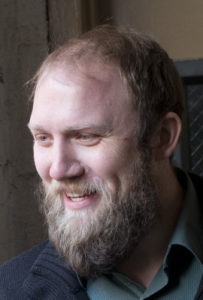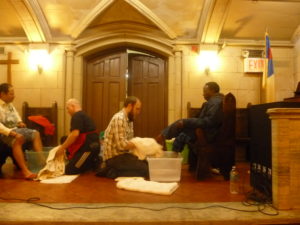 Jason Storbakken is Director of Chapel & Compassionate Care at The Bowery Mission. He is an ordained minister in the Mennonite Church USA and author of “Radical Spirituality: Repentance, Resistance, Revolution” (Orbis).
Jason Storbakken is Director of Chapel & Compassionate Care at The Bowery Mission. He is an ordained minister in the Mennonite Church USA and author of “Radical Spirituality: Repentance, Resistance, Revolution” (Orbis).
The feet and legs of the homeless men we serve at The Bowery Mission are a testimony to the pain they endure daily. Many of their legs are swollen because, like Jesus, they have “nowhere to lay [their] head to rest.” They wander the streets and subways, ride on free casino buses, and sit in libraries and other public spaces.
Many men sleep upright a couple hours and are then asked to move on, rarely sleeping flat with their legs elevated, which would allow healthy blood circulation. Sometimes their legs are hardened so badly that they feel like stone or wood rather than flesh. Occasionally, we need to send these men to the hospital where they are injected with blood thinners to reduce the swelling. One friend in the community, who goes by the nickname Wheelchair Charlie, eventually had both legs amputated and later died of complications related to blood clots.
On Maundy Thursday, I will lead the foot-washing service at The Bowery Mission during the noon chapel. Over the last few years Uros Markovic (who plays Gospel Jazz every Friday night at the Mission) and I have led the foot-washing service. This year my colleague Delon Ali, who was homeless for several years and is now an ordained minister, will bend low with me to wash the feet of our friends.
The Bowery Mission has a rich history. It was founded in 1879. Fanny Crosby wrote many of her famous hymns at the Bowery – we still have her piano! – and the first congregation to sing many of her songs were the homeless community that gather here. Charles Sheldon was a minister at The Bowery Mission (and writer for the Christian Herald, the Mission’s umbrella organization) when he wrote “In His Steps” also known as What Would Jesus Do. It was also at The Bowery Mission where Henry Louis Klopsch, an early director of the Mission, created the Red Letter Bible.
Often during the service a staff person or member of the community will play hymns on the piano, such as “Blessed Assurance” and “Pass Me Not, O Gentle Savior”. Someone will surely read John 13:1-17, the passage where Jesus washed the feet of his disciples.
After a person has their feet washed, the tubs are emptied and refilled with hot, soapy water. We also make sure there are plenty of towels and washcloths. There are usually a couple of dozen people who come forward to have their feet washed. Many churches have annual foot-washing services, although most parishioners at these mainline or evangelical churches will arrive with feet already washed and perhaps pedicured! Our community may shower twice a week if they make both shower days, and many have crusty socks, gnarled toes and severely calloused feet. Over the years many of them have mentioned that they had never had someone wash their feet. Our community sometimes comes a bit funky, but I believe that is where God meets us – in the midst of our funk and mess and vulnerability.
There is a deep intimacy and trust when a person allows another to wash their feet. I recall one person saying it felt “spiritual” but couldn’t quite explain why. Another person said that he was now inspired to do something good for others. After thoroughly scrubbing one man’s feet, I looked up to see him crying. He said that he seldom has any sort of physical contact with others and that he feels invisible as he walks the street.
Last year while waiting for the tub to be refilled, I walked down the chapel aisle to encourage the men and women in the community. One man was standing with his arms extended to the heavens worshiping God. As I passed, he said that he had suffered with chronic pain in his shoulder for many years and that during the service he felt miraculous healing.
The Spirit of Jesus is very present on the Bowery. It is humbling to wash feet, and it is evident that it is often humbling for many of the men to have their feet washed.

